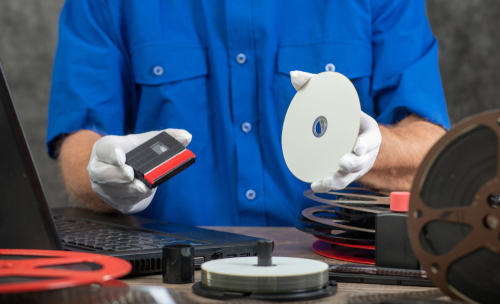2021
pm
Hi8 vs. MiniDV A Detailed Comparison Written by: Brandon Harris, Smooth Photo Scanning Services

Home videos were a staple of the second half of the 20th century. As technology allowed cameras to get smaller and more portable, families across the country (and the world) discovered the wonders of being able to capture the most precious moments and relive them for many years to come.
And a big part of that process was the introduction of Hi8 and MiniDV tapes, both of which played a pivotal role in making home movies more accessible, enjoyable, and affordable for millions of people in the country.
However, just as with any technology, sooner or later, something better comes along and changes how we use it. And that’s why today, Hi8 to digital service providers, just as Mini DV to digital service providers, have their work cut out transferring old tapes into a digital format.
But what are Hi8 and MiniDV, anyway? And how do they compare with each other, as well as with the digital alternatives available today? Let’s answer these questions below.
The History of Hi8
For a long time, VHS (or the smaller S-VHS) were the dominant tape formats used in home videos. But the problem was that they were quite bulky, which meant having to use larger cameras. They also didn’t provide the best quality.
That’s why when the Hi8 format was introduced in 1989, it took the video world by storm, capturing the imaginations of video production enthusiasts and providing newfound opportunities for creating high-quality home videos more conveniently.
These tapes significantly reduced the size of the camcorders, providing an incredibly portable way to take the camera on the go without much trouble. People could use them on vacations when going on hikes, which would have been impossible with the heavy filming equipment of the past.
But that’s not the only reason that made Hi8 so popular. Even though today Hi8 to DVD service is on the rise, these tapes had a lot to offer and were once the pinnacle of video camera technology.
For one thing, it significantly improved the resolution, bandwidth, and overall picture quality, providing a better overall experience that amateur filmmakers could enjoy. In addition, the Hi8 tapes could also record videos of up to 120 minutes, which was an impressive length that provided much more flexibility.
Compared to the 8mm tapes that came before, Hi8 was simply the better option in most regards. But, as we’ll learn in the next chapter, it wasn’t long until an even more advanced technology came out and disrupted the industry once again.
The History of MiniDV
Just six years after the release of the Hi8, the MiniDV took another step towards the recording quality we have today, introducing even more powerful features at a mere 6mm, which was another breakthrough in the camcorder tape size.
In fact, professional-grade versions of the tapes were used in various productions for the upcoming years until it was eventually overtaken by the Digital8 format that offered even more robust capabilities.
Some of the things that made MiniDV stand out were colors that were much sharper than its predecessors, a better resolution, PCM audio recording, and a range of other features that made MiniDV an excellent choice for both amateurs and professionals.
What’s more, MiniDV was actually the first digital video format tape, which made it easier to transfer it to another format later on.
And since the format was so popular, Mini DV to digital service providers are still busy helping people ensure that their MiniDV tapes are transferred without losing the quality of the picture.
Why It Makes Sense to Digitize
It may seem that since these tape formats are relatively recent, you may not necessarily need to digitize them and could get by with storing them in the current formats. But while the technology behind both formats is certainly impressive, using a convert Hi8 to digital service is the only way to ensure that your tapes do not get destroyed or deteriorate over time.
By using an Hi8 to digital service, you don’t have to worry about losing your precious memories. And you also don’t have to worry about taking on the complicated process of digitizing your tapes on your own.
Mini DV to DVD service providers has the necessary technology to ensure that your tapes are protected and digitized by preserving (and even enhancing) the quality of the footage. But at the same time, every year you wait for means that restoring the quality might become more complicated, even for professionals.
And finally, by getting your MiniDV and Hi8 tapes digitized, you will have a much easier time actually enjoying them. You can share the footage with friends, send it to family members through the internet in mere seconds, and quickly make backups that will keep your precious memories protected no matter what might happen.


